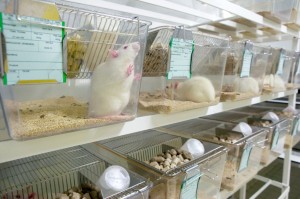How Do Lab Doctors Wakeup Lab Animals From Bed
Researchers debate well-nigh humane methods of dispatch.

Much of the discussion virtually the humane killing of enquiry animals centres on rodents. Credit: PASCAL GOETGHELUCK/SCIENCE PHOTO LIBRARY
Killing research animals is i of the most unpleasant tasks in science, and it is imperative to do information technology as humanely as possible. Just researchers who report animal welfare and euthanasia are growing increasingly concerned that widely used techniques are not the least painful and least stressful available. This week, experts from beyond the earth will assemble in Newcastle upon Tyne, United kingdom, to contend the evidence and attempt to accomplish a consensus.
"There are lots of assumptions made about the humaneness of various techniques for euthanizing animals," says Penny Hawkins, deputy head of the research animals section at the Royal Society for the Prevention of Cruelty to Animals, a clemency based in Southwater, United kingdom of great britain and northern ireland. "Sometimes an animal might non appear to exist suffering, but might be conscious and suffering."
Much of the debate centres on rodents, which brand up the vast majority of research animals. Current techniques for killing them include inhalation methods — such as chambers that fill with carbon dioxide or anaesthetic gases — and injecting barbiturates. Physical methods include cervical dislocation (breaking of the neck), or decapitation with specialist rodent guillotines (run across 'Methods used to impale lab rats').
Experts hotly contend which method is preferable. The most-discussed question at the coming together is likely to be about the apply of CO2.
"People do notwithstanding worry well-nigh CO2 and it's yet almost certainly the most widely used method [for killing rodents],"says Huw Golledge, who studies the anaesthesia of lab animals at Newcastle Academy, Great britain. Golledge organized the meeting, which is backed by the London-based National Centre for the Replacement, Refinement and Reduction of Animals in Inquiry. Its aim is to update a 2006 consensus document produced by international experts to give guidance to researchers working with animals.
CO2 is used to make rodents unconscious. They are so killed by either asphyxiating them with the gas, or by another method. Simply increasingly, studies advise rodents find CO2 stressful.
Evidence for this comes mainly from 'aversion studies'. A key study by animal welfare researcher Daniel Weary's group at the University of British Columbia in Vancouver, Canada, shows that albino rats will move away from a dark compartment filling with COtwo into a brightly lit box, despite disliking bright lights. The study found that they were less likely to motion away from isoflurane, likewise used in euthanasia (D.Wongetal.Biol.Lett.http://doi.org/ncv;2012).
Other show is contradictory (H. Valentine et al. J. Am. Assoc. Lab. Anim. Sci. 51, 50–57; 2012), only Weary is house in his beliefs. "Our ain results signal CO2 is highly aversive," he says.
There are likewise question marks over physical methods. Performed perfectly with animals accepted to being handled, cervical dislocation may be the all-time method, merely it may not exist practical for killing large numbers of rodents.
The bug are even more uncertain for the new beast models that scientists are pursuing. For example, a huge increase in the use of zebrafish has put them on the meeting's agenda. Although much progress has been made with lab rodents, says Weary, "there's been much less work on fish welfare in general".
Widely used guidelines on brute euthanasia from the American Veterinary Medical Association (AVMA) in Schaumburg, Illinois, were updated before this yr, in part to adapt to changes in the animals used in labs, with zebrafish guidance ane of the additions. The association says it expects the lab animals department of these guidelines to continue to expand.
Some of this guidance comes with regulatory teeth. Later this twelvemonth, the The states National Institutes of Health, which funds biomedical research, says that it expects "full implementation" of the AVMA guidelines, with previously approved projects reviewed using them.
Regulation is also driving more unusual animals onto the agenda. New legislation on the treatment of laboratory animals is currently beingness incorporated into the laws of European Spousal relationship member states and will cover cephalopods, in some nations for the first time (run across Naturehttp://doi.org/fk65pb;2011).
Related links
Rights and permissions
Virtually this article
Cite this commodity
Cressey, D. All-time way to kill lab animals sought. Nature 500, 130–131 (2013). https://doi.org/10.1038/500130a
-
Published:
-
Upshot Date:
-
DOI : https://doi.org/10.1038/500130a
Further reading
Source: https://www.nature.com/articles/500130a
Posted by: cokerdiethat.blogspot.com

0 Response to "How Do Lab Doctors Wakeup Lab Animals From Bed"
Post a Comment